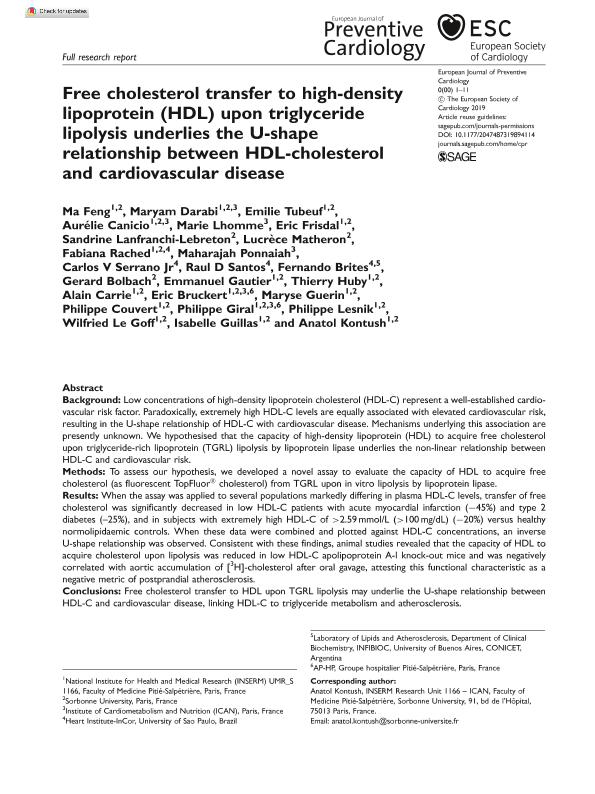Artículo
Free cholesterol transfer to high-density lipoprotein (HDL) upon triglyceride lipolysis underlies the U-shape relationship between HDL-cholesterol and cardiovascular disease
Feng, Ma; Darabi, Maryam; Tubeuf, Emilie; Canicio, Aurélie; Lhomme, Marie; Frisdal, Eric; Lanfranchi Lebreton, Sandrine; Matheron, Lucrèce; Rached, Fabiana; Ponnaiah, Maharajah; Serrano, Carlos V.; Santos, Raul D.; Brites, Fernando Daniel ; Bolbach, Gerard; Gautier, Emmanuel; Huby, Thierry; Carrie, Alain; Bruckert, Eric; Guerin, Maryse; Couvert, Philippe; Giral, Philippe; Lesnik, Philippe; Le Goff, Wilfried; Guillas, Isabelle; Kontush, Anatol
; Bolbach, Gerard; Gautier, Emmanuel; Huby, Thierry; Carrie, Alain; Bruckert, Eric; Guerin, Maryse; Couvert, Philippe; Giral, Philippe; Lesnik, Philippe; Le Goff, Wilfried; Guillas, Isabelle; Kontush, Anatol
 ; Bolbach, Gerard; Gautier, Emmanuel; Huby, Thierry; Carrie, Alain; Bruckert, Eric; Guerin, Maryse; Couvert, Philippe; Giral, Philippe; Lesnik, Philippe; Le Goff, Wilfried; Guillas, Isabelle; Kontush, Anatol
; Bolbach, Gerard; Gautier, Emmanuel; Huby, Thierry; Carrie, Alain; Bruckert, Eric; Guerin, Maryse; Couvert, Philippe; Giral, Philippe; Lesnik, Philippe; Le Goff, Wilfried; Guillas, Isabelle; Kontush, Anatol
Fecha de publicación:
12/2019
Editorial:
Sage Publications Ltd
Revista:
European Journal of Preventive Cardiology
ISSN:
2047-4873
Idioma:
Inglés
Tipo de recurso:
Artículo publicado
Clasificación temática:
Resumen
Background: Low concentrations of high-density lipoprotein cholesterol (HDL-C) represent a well-established cardiovascular risk factor. Paradoxically, extremely high HDL-C levels are equally associated with elevated cardiovascular risk, resulting in the U-shape relationship of HDL-C with cardiovascular disease. Mechanisms underlying this association are presently unknown. We hypothesised that the capacity of high-density lipoprotein (HDL) to acquire free cholesterol upon triglyceride-rich lipoprotein (TGRL) lipolysis by lipoprotein lipase underlies the non-linear relationship between HDL-C and cardiovascular risk. Methods: To assess our hypothesis, we developed a novel assay to evaluate the capacity of HDL to acquire free cholesterol (as fluorescent TopFluor® cholesterol) from TGRL upon in vitro lipolysis by lipoprotein lipase. Results: When the assay was applied to several populations markedly differing in plasma HDL-C levels, transfer of free cholesterol was significantly decreased in low HDL-C patients with acute myocardial infarction (−45%) and type 2 diabetes (–25%), and in subjects with extremely high HDL-C of >2.59 mmol/L (>100 mg/dL) (−20%) versus healthy normolipidaemic controls. When these data were combined and plotted against HDL-C concentrations, an inverse U-shape relationship was observed. Consistent with these findings, animal studies revealed that the capacity of HDL to acquire cholesterol upon lipolysis was reduced in low HDL-C apolipoprotein A-I knock-out mice and was negatively correlated with aortic accumulation of [3H]-cholesterol after oral gavage, attesting this functional characteristic as a negative metric of postprandial atherosclerosis. Conclusions: Free cholesterol transfer to HDL upon TGRL lipolysis may underlie the U-shape relationship between HDL-C and cardiovascular disease, linking HDL-C to triglyceride metabolism and atherosclerosis.
Archivos asociados
Licencia
Identificadores
Colecciones
Articulos(OCA HOUSSAY)
Articulos de OFICINA DE COORDINACION ADMINISTRATIVA HOUSSAY
Articulos de OFICINA DE COORDINACION ADMINISTRATIVA HOUSSAY
Citación
Feng, Ma; Darabi, Maryam; Tubeuf, Emilie; Canicio, Aurélie; Lhomme, Marie; et al.; Free cholesterol transfer to high-density lipoprotein (HDL) upon triglyceride lipolysis underlies the U-shape relationship between HDL-cholesterol and cardiovascular disease; Sage Publications Ltd; European Journal of Preventive Cardiology; 12-2019; 1-11
Compartir
Altmétricas



